Without an effective ecommerce sales funnel, you’re losing money.
You can’t just pop open your online store and expect visitors to pull out their credit card.
There’s a process you can take to generate leads and maximize revenue.
In this post, we’ll cover the secrets of building effective sales funnels alongside practical examples of brands crushing it online.
Stick to the end.
What is an Ecommerce Sales Funnel?

A sales funnel is the path a potential customer journey through to become a customer and a brand ambassador.
Neglecting buzzwords and content marketing jargon, a sales funnel is simply creating an easy buying process for your customers. At the same time guiding them through the purchasing process.
Pre-designing the path, adding follow-up automation, driving traffic, and every other marketing tactics are to simplify the buying process for your potential customers.
Backed by research, companies with an easy buying process are 62% more likely to win a quality sale.
The secret to recurring customers and sales is simplifying the process and providing an excellent customer experience to them.
Most ecommerce stores have a sales funnel but it’s a broken funnel. Hard to find an ecommerce store or online business without some of the elements of a sales funnel.
Here are some of the elements of an ecommerce conversion funnel:
- Lead magnets (Lead generation is an integral part of an ecommerce funnel)
- Upsells, downsells, and order bumps.
- Follow-up email sequence
- Cart abandonment reminder
- Transactional emails
- Good customer experience
If you have an upsell for your product or have automated follow-up emails set up on your ecommerce store, you have a funnel.
However, it’s likely you don’t know this or you are part of the 68% that are yet to measure the effectiveness of their sales funnel.
And that little line is the difference between an effective and non-effective ecommerce funnel.
Still on that, here’s a breakdown of the differences.
Here is how you know your ecommerce conversion funnel is broken.
- It is underperforming and hardly converting.
- You cannot track its effectiveness.
- It is hard to define which steps are working and which are not.
A successful ecommerce conversion funnel should be able to do the following:
- Turn prospects into paying customers
- Have a clear roadmap (clear stages with their roles well defined)
- Easy to track metrics
Why You Need an Ecommerce Sales Funnel
Unconvinced about the importance of a sales funnel for your ecommerce stores? Here are some reasons why you need it.
- An ecommerce funnel bumps up your conversion rates and profit margins. It effectively directs your prospects on a journey that details their problems and presents the solution.
- It runs on autopilot (without your involvement) and helps turn prospects into customers at the end of the journey.
- A sales funnel helps you organize your sales process. It sends the right message at the right time.
- It helps you spot which part of your sales process is faulty and which is converting. You can use the metrics it presents to improve your marketing strategy. Likewise, it helps you identify the weaknesses in the process and where you are losing prospects.
- An ecommerce funnel increases your revenue. It organizes your sales and helps increase your profits compared to without. You can retarget lost customers better with a personalized purchasing process.
With all these amazing benefits, an ecommerce conversion funnel is a necessity for your online store. If you already have a sales funnel set up and it isn’t converting and bringing smiles to your face and cash to your pocket, you’re doing something wrong.
In the next section, we’ll cover how to set-up an ecommerce sales funnel that converts and brings crazy profit margins.
Learn how to redefine your ecommerce experience and join the successful players with a properly structured ecommerce conversion funnel.
But before that, let’s dive into the stages of an ecommerce funnel.
Stages Of The Funnel
There is no universally acceptable number of stages for an ecommerce funnel. It depends on the number of steps needed to convert prospects into customers.
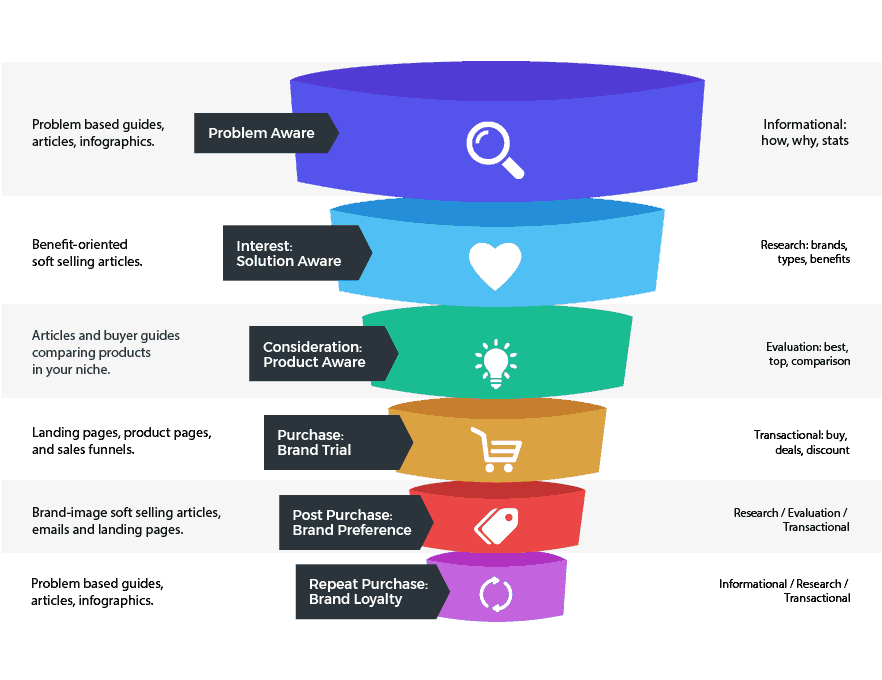
Essentially, all ecommerce conversion funnels have to include these stages to be successful:
- Awareness Stage
- Consideration/Evaluation Stage
- Purchase Stage
- Post-Purchase
- Repeat Purchase
The Awareness Stage (Top of the Funnel, TOFU)
This is the very top of the sales funnel. It is the first place the traffic you are pulling your target audience to. The goal of this stage is to create brand awareness and address your prospects’ problems and possible solutions.
It is the stage, you connect with your prospects about their pain points via content marketing SEO or advertising.
It encompasses all steps taken to make prospects more informed about their problem and the solution. That’s why keyword research is essential. It will help you discover what your customers are searching for on Google or even Amazon. The goal of this stage is to get your brand in front of people in your target audience for the lowest cost.
The Consideration/Evaluation Stage
This stage follows just after the Awareness Stage. It’s the middle of the funnel.
In the previous stage, you made the prospects feel comfortable by offering free information about their problem like a friend.
This Stage is where you make your move. Your prospects are now aware of the problems they face. Now, the next step is to tell them the solution and position your brand as the solution (product-aware).
Your offer has to be good because your prospects are considering different options now which you are among. The goal of this stage is to convert visitors into email subscribers.
Purchase Stage (Bottom Of The Funnel)
This is the stage of the sales funnel where you expect your prospects to decide to buy your products.
All the prior steps or stages in the sales funnel contribute to convincing your prospects to make that final purchasing decision.
Post-Purchase
This stage encompasses what happens after the first purchase. In this stage, you keep the loop open to make it easier for your customers to become repeat customers. You set up email sequences and follow up on your customers.
By consistently engaging with your customers after purchase, you can easily cross-sell or upsell them to a higher package.
Repeat Purchase
Finally, here’s the promised land for all businesses; repeat sales and loyal customers.
You have gotten your prospects to make the first purchase. Now you have to keep them for a long (if not) lifetime.
The longer you retain your customers and keep them coming back, the more profit you make.
It’s easier to keep old customers than it’s to get a new customer. The ultimate goal of a sales funnel is obtaining repeat sales, customer testimonials and product recommendations.
While the stages mentioned are common, it is worth noting that there is no exact length for a conversion funnel.
“Sales funnel mirrors the buyer’s journey. It can be shorter than the stages mentioned or longer.”
Prospects are different and take their unique journeys down the sales funnel. Some customers are easy to persuade while some take time and more steps to convince.
“A good sales funnel is not rigid but able to accommodate the peculiarities of different prospects.”
A Funnel Framework for Higher Conversions
Here’s the real deal. After all said, how do you build an effective funnel?
Irrespective of your product niche, the below framework will help you in building an effective sales funnel.
But to start with, it’s wise to note that building an ecommerce sales funnel doesn’t mean throwing away your present suite of tools.
Neither does it mean getting any premium ecommerce sales funnel builders, it’s a matter of reworking your ecommerce store for a better experience for your customers.
Let’s dig further.
1. Map out your Ecommerce Site
This is the first and a major step in building an effective sales funnel. The secret of effective sales funnels lies in your online store.
Start by mapping and visualizing the path your potential customers must go through. This helps you make the purchasing process easier.
If you know the virtual path your customers would go through, you’ll be able to provide necessary information to guide them through the purchasing funnel.
Sadly, a lot of ecommerce stores are just a display of different products without a single part addressing prospects or directing them where to go.

This drags the buying process making the ROI on advertising poor.
Except you have enough funds for advertising like the big guys. If not, you need to map out a clean and easy to use ecommerce store.

Your store should grab your customers’ attention providing them the necessary details about the product and social proof.
As expected, several factors contribute to achieving this.
- Navigation: To map out a clean online store, your site navigation cannot be neglected.
How easy is it for your customers to navigate around your store? Either to find a product, make a purchase, contact you, etc; the navigation must be simple.
Sacrificing easy navigation for a sophisticated store isn’t a good plan. It’s better to keep it simple to make the process easier for your prospective customers.
- Clearly-Defined Pages: As a rule, make your product pages simple and easy to understand. Your landing pages must be clearly defined.
Because most times, this is where you direct your ads traffic to. So, your landing page has to talk to your target market.
That said, your product description should be appealing too. It should clearly describe the product.
Likewise, always provide social proof on your product pages. It builds trust and displays your brand’s authenticity. An excellent example is SkinnyMeTea which uses user-generated content on their product pages.
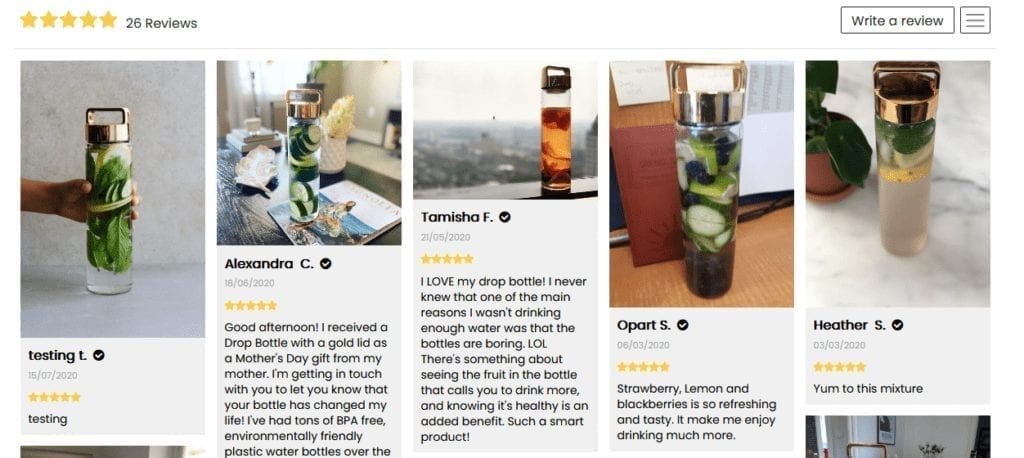
- Your store must have clear CTAs: From the “add to cart” button to the end of the purchasing funnel, make your click-to-actions clear and simple.
Your customers shouldn’t have to look for the “add to cart” button on your store.
It’s your job to make your CTAs visible and clear.
2. Add Upsells, Downsells, and Order Bumps
This is an essential element of an ecommerce funnel. These are also known as one-time-offers.
Upsells are additional offers you introduce to your customers after purchasing the main product. It’s asking your customers to buy a more expensive product after their first purchase. You upsell them to a higher package.
Likewise, for downsells, it’s offering a cheap alternative to your customers, as a backup for your upsell.
Similar to upsells, an order bump introduces an additional product to your customers. But this is before they make their first purchase. They add it to the cart before making the purchase.
Finally, cross-selling is the act of introducing an additional product that supplements the main product.
The logic here is that by introducing additional products to your customers, you increase the average order value.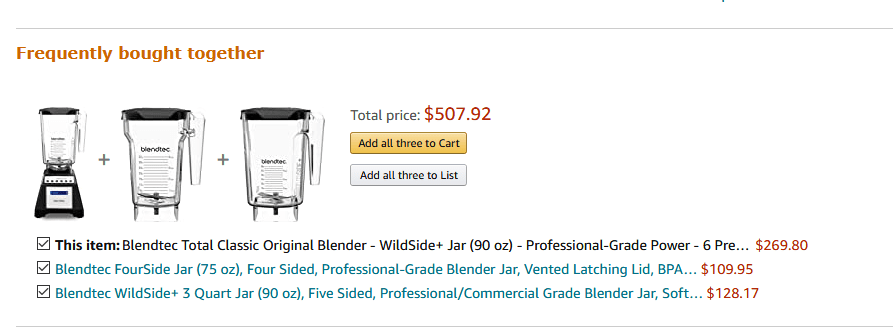 For instance, Amazon frequently introduces supplementary products to increase the average order value.
For instance, Amazon frequently introduces supplementary products to increase the average order value.
Not adding order bumps and other one-time-offers (OTO) to your funnel deprives you of more sales and revenue. And most times, this is where the magic lies.
For instance, Peng Joon, an affiliate and ecommerce marketer made over a million dollars from upsells alone while making his initial product literally free. That’s the real power of upsells and other OTOs.
3. Setup Email Sequence Series
Email marketing is an integral aspect of a conversion funnel. You need an email automation tool to keep in touch with your prospects.
From signing up to your email list to making their first purchase, you need to automate the communication between you and your customers.
Your email sequence must be set for both pre-purchase and post-purchase.
The pre-purchase email sequence helps you follow-up on your website visitors after leaving your store without completing the purchasing process.
For instance, while your website visitors are browsing your store, you collect their emails by offering a lead magnet. And with that, you follow-up with your pre-designed email sequence.
When following up, you introduce discount offers and other attractive offers that draw prospective customers back to the order page.

With the average cart abandonment rate being 70%, if you aren’t capturing emails and following up on prospective customers, you are leaving a lot of money on the table.
Subsequently, after buying a product from your store, what’s next? Do you just say goodbye or you keep in touch with them?
The right thing to do in a healthy funnel is to keep the funnel open. A one-time-sale isn’t the goal of a marketing funnel, it’s to keep getting recurring sales.
By opening the loop even after purchase, you increase the chances of getting more sales. And that’s where the post-purchase email series comes in handy.
You follow-up on customers that have purchased your product sending them discounted offers and upsells.
Later on in the future, you can cross-sell other products to them or introduce them to a loyalty program via email marketing or retargeting ads.
4. Add a Thank You Page
A thank you page does a lot in a funnel. It deepens the relationship between you and your customers.
Not just the usual thank you page, your thank you page should include the necessary things that your customers should know after purchase.
This includes the transactional details. Possibly, it could include a link to a freebie as a note of thank you to your customers.
Your thank you page is also the perfect place to upsell customers to a premium package.
5. Include Exit-Intent Popups
Besides following up with prospective customers that abandoned their carts, exit-intent popups help you persuade potential customers to stick around.
Just before leaving your ecommerce website, you target them with a freebie or lead magnet to attract them.
By so doing, you can get their email address and follow up on them.
Below is a typical example of an exit-intent popup :

However, a rule of thumb is for your lead magnet to solve a problem your prospects have. Likewise, it must be related to your products.
It doesn’t have to be a free product or free shipping, it could be a free webinar, eBook, promo codes, etc.
You just have to ensure it solves a problem your prospects’ have.
6. Drive Traffic to your Conversion Funnel
The whole idea of a conversion funnel is useless if you aren’t driving traffic to your ecommerce store.
Traffic is the fuel of a successful ecommerce conversion funnel.
While there are many options for driving traffic to your online store, the below ones are very popular among ecommerce businesses:
- Facebook ads
- Instagram ads
- Influencer marketing
These three traffic sources are popular among ecommerce store owners.
Facebook ads are a powerful way to drive awareness to your ecommerce store and at the same time generate sales.
Facebook’s audience targeting filter allows you to target the right buyers’ persona. It allows you to narrow your audience based on their demographics, interest, behavior, and many other categories.

Likewise, by adding Facebook pixels to your website, you can retarget your website visitors.
Similar to Facebook ads, Instagram ads are also an effective traffic generation method. Besides, Instagram ads use the same advertising system as Facebook.
You get the same targeting filter options as you have on Facebook also.
On the other hand, influencer marketing has been proven to be more effective. In a survey by MediaKix, 89% of people claimed that ROI from influencer marketing is comparable to or better than other marketing channels
Influencers drive more sales thanks to their loyal followers. And the best part is, you can get an influencer that is within your budget.
By finding the right influencer to work with, you can generate awareness and drive traffic to your funnel.
Unlike other promotional methods, influencer marketing doesn’t require any technical know-how.
Many ecommerce businesses use Instagram influencers a lot compared to other platforms. And that’s because of its engagement rate.
However, many other social media platforms are on the rise.
TikTok is presently on the rise. There are a lot of influencers on TikTok creating short videos. You can leverage their influence to drive awareness and traffic to your ecommerce funnel.
At the same time, YouTube has also become home to influencers. Youtubers are always looking out to collaborate with brands.
A rule of thumb when choosing an influencer is to consider your target market.
Reach out to an influencer whose followers are your prospective customers. Another rule of thumb is to not neglect micro-influencers.
They are proven to generate more engagement and ROI compared to influencers with a very large following. And that’s because they engage better with their followers.
Using Influencer marketing, Gretta Van Riel was able to grow 5 multi-million dollar ecommerce brands. (more on this below).
7. Identify Leaks and Fix
At this point, you have a functional ecommerce sales funnel. You’re consistently driving traffic to the funnel while the funnel is converting nicely.
Think you’re done? It’s time to fix the leaks in the funnel.
As you start generating traffic to your sales funnel, you’ll identify leaks in the funnel.
The points where potential customers are dropping off will be clearer. Is it the sales page? Is it the checkout page? Is it the order page?
By fixing the leaks, you improve the efficiency of your sales funnel.
Thinking that a sales funnel template or imitating a competitor would do the work, you’re farther away from being right.
“Effective and efficient sales funnel isn’t a product of a copied sales funnel template, it’s the product of understanding how your customers relate with your ecommerce store”
An efficient sales funnel is personalized to suit your customers. It’s a product of understanding the interaction between your customers and your ecommerce store.
That’s the underground definition of an efficient sales funnel.
When you understand how your customers interact with your ecommerce store, you’ll know how to make their purchasing process painless and easy.
8. Measure your Result
Now, I agree we are almost there. It’s time to measure your results.
Here are some metrics to know if your sales funnel is performing well:
- Conversion rate: The conversion rate is the most important metric that gives clear details about the performance of your ecommerce conversion funnel.
An effective ecommerce funnel should increase your conversion rate. If there’s no increase in your conversion rate, then you need to identify the leaks and fix them.
- Average Order Value (AOV): The average order value of your customer is another metric that tells you how much your customers are spending on your ecommerce store.
They would only spend more if they are satisfied. So, if you experience an increase in your average order value (AOV), then you’re doing it right.
If it’s the opposite, identify the leaks and fix them!
- Cart Abandonment Rate: Your cart abandonment rate is another metric to measure. You need to know if it’s dropping or not.
The rate at which your customers abandon your cart should reduce. A decreasing abandonment rate is a pointer that your ecommerce funnel is effective.
Ecommerce Sales Funnel Examples
Heck, what’s more, interesting and explanatory than taking a look at some examples?
Right here, we’ll take a look at some popular ecommerce funnel examples. And at the same time take a look at ecommerce businesses leveraging these funnels.
Let’s dig deeper.
Free Plus Shipping Funnel (Dean Graziosi)
Free plus shipping is a popular ecommerce funnel trick that gets customers to take action.
Literally, it isn’t free since you’ll be paying for the shipping of this product. But the word “free” appeals to a lot of people than you could think of.
While as an ecommerce business owner, at this front end, you don’t make a huge profit. But by adding a premium upsell, you make back a whole lot of profit.
So, the goal of a free-plus-shipping funnel is to get your prospective customers into your sales cycle.
Once they hit that button, you upsell them with a higher package.
Here’s how it goes:
- You drive traffic to your free plus shipping landing page
- Your customers complete the checkout process (and you get their email address)
- You introduce an upsell to them (here’s the real game-changer)
- You follow up with them for future sales

Source – Torchbankz
A good number of successful ecommerce businesses use the free plus shipping funnel.
Dean Grazioso is a typical example. He uses free plus shipping to sell his premium products.
Dean Graziosi offers his book as a free plus shipping offer.

Immediately after filling in your shipping information, Dean introduces two one-time-offers.

And that’s exactly where he gets most of the profit. For the book, it should cover the advertising cost.
Besides Dean, many others have grown their businesses using the free-plus-shipping funnel.
SkinnyMeTea Free Shipping Funnel
Very similar to the free plus shipping funnel, SkinnyMe Tea, an Australian based company that sells TeaTox products, uses social proof and free shipping to attract prospective customers.
SkinnyMe Tea starts with warming-up prospective customers. It then directs them to the order page introducing one-time-offers.
Here’s how it works.
Prospective customers find SkinnyMe Tea ads on Facebook and Instagram promoting their 50% discount alongside free shipping.

A click on of the ads takes you to their aesthetic sales page which does nothing but to show you proof that the product works.
It starts with some social proof showing reviews (user-generated content) left by happy customers.
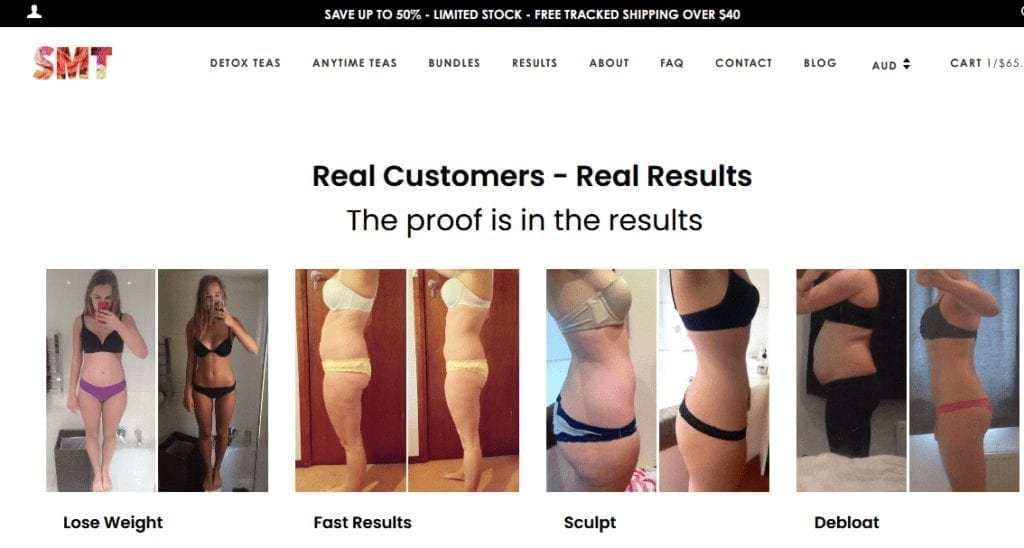
In the middle of the page, SkinnyMe Tea directs prospective customers to their order page where you get to shop right away.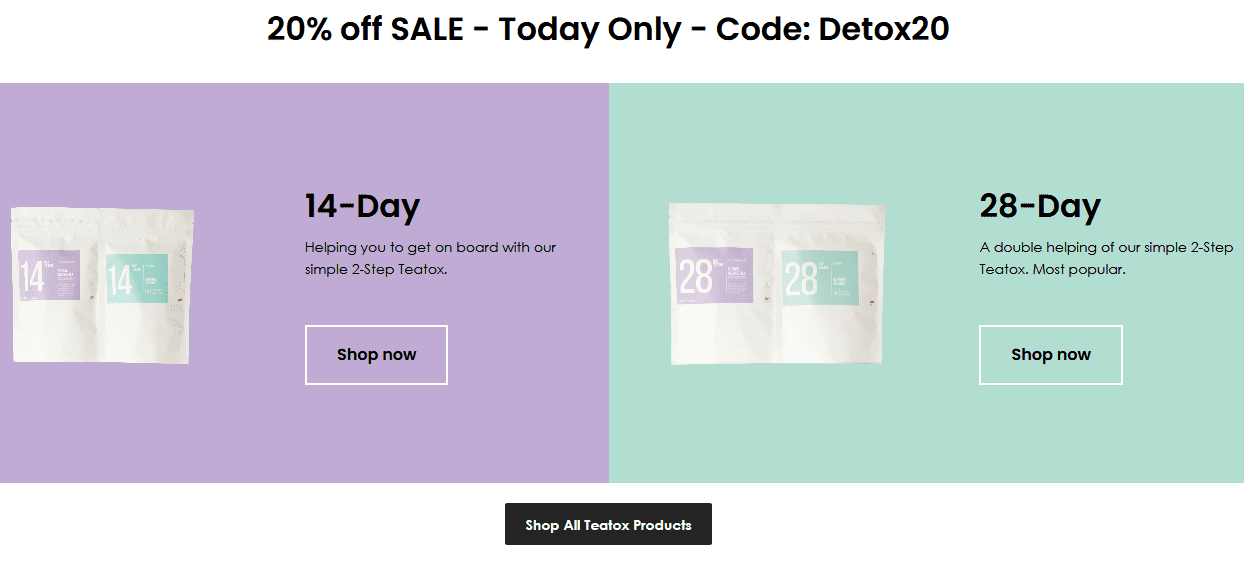
The most attractive element on SkinnyMe Tea landing pages is its user-generated content acting as the social proof.
Similar to the sales page, SkinnyMe Tea displays more reviews and social proof that encourages online shoppers to take action on their order page.

Finally, when you bite it and click on the “add to cart” button which leads you to the checkout page, SkinnyMe Tea then introduces additional offers.
For instance, it offers you a gift (free strawberry tea strainer) on the checkout page.

This isn’t a common conversion funnel. SkinnyMe Tea is one of the ecommerce businesses with strong use of social proof and reviews.
There are lots of images and user-generated content to urge potential buyers to take the desired action.
Besides the above example, there are other practices implemented on SkinnyMeTea online store.
For instance, this Australian-based company collects website visitors’ email addresses in exchange for a 10% off promo code on their first purchase.
Did it work? It worked wonders, their email lists and traffic conversion grew astronomically. Its email opt-in increased by 758%

Speaking about other practices, SkinnyMe Tea leverages influencer marketing to drive traffic to their marketing funnel.
Building a collective social media following of 16million across multiple accounts was a win for Gretta Van Riel and her ecommerce brands.
Using a similar ecommerce funnel, Gretta has grown four other multi-million dollar ecommerce businesses including The 5th Watches and DropBottle.
Webinar Sales Funnel
The webinar sales funnel is becoming very popular for knowledge-based businesses. And the reason for that is clear.
Webinars are a perfect way of providing value to prospective customers. With a webinar, you inform your prospects about their problem and also sell your product to them.
Besides that, it allows you to collect your prospects’ email addresses thereby nurturing the relationship with them.
Here’s how it works:
- You launch a webinar and design essential pages
- Drive traffic to your registration page (you collect their contact information which includes their email address and at the same time survey them)
- Send them pre-webinar notifications
- After educating and offering value, you introduce your product
- Post-webinar follow-up
- Sales
Amy Porterfield is one of the entrepreneurs who have successfully cracked the code of the webinar sales funnel.
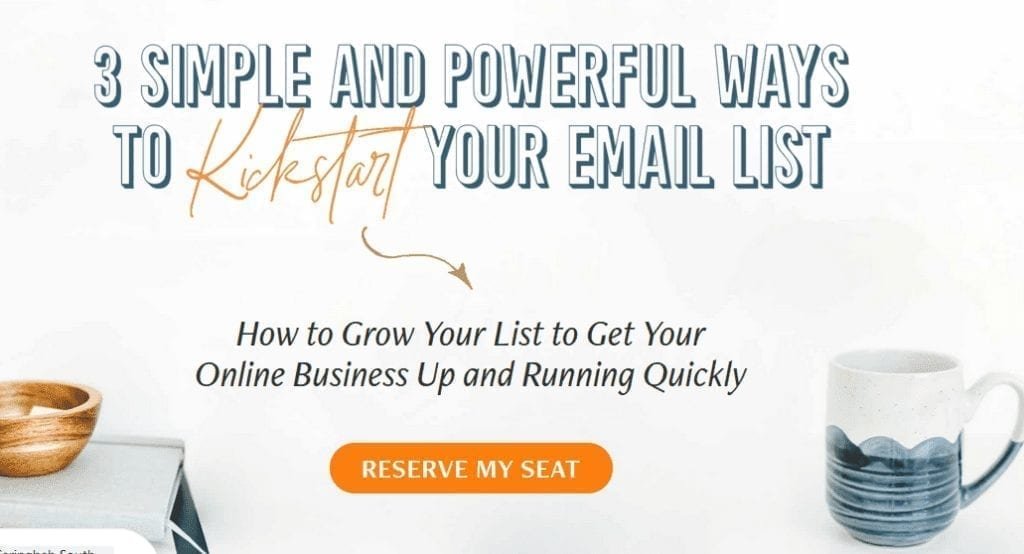
Amy Porterfield finds her prospects by running Facebook ads to freebies and webinars.
On the registration page, she collects her prospects’ contact information.

Immediately after the registration page, she surveys her registrants on their problems. And this gives her insight into new products.
During the webinar, Amy introduces her premium products to her attendees.
Here’s the thing. Even if only a few of the attendees buy the premium product, she will follow up with the rest via an email sequence.
Wait, speaking of webinars, evergreen webinars are a great way of automating the sales process.
You don’t want to keep hosting live webinars. Instead, you want to make a webinar and keep using it to generate leads and sales for your ecommerce store.
Driving Your Ecommerce Marketing Optimization
Going forward, building an ecommerce conversion funnel doesn’t have to be hard. Several multi-million dollar companies were birthed thanks to a proper conversion funnel strategy.
You too can build your ecommerce funnel to convert crazily like the examples discussed above.
You just have to:
- Identify your ideal prospect
- Keep it simple. Don’t overcomplicate the process.
- Organize your sales funnel and set it up to convert.
- Drive traffic to your funnel using Paid Ads and Influencer Marketing.
- Test your conversion funnels.
- Keep track of your metrics and don’t be scared of trying out new things.
In the end, the goal is to make the buying process and experience for your customers easy and simple. Having a funnel can help you maximize your marketing efforts.
Have you ever tried building or fixing an ecommerce funnel? What was your experience?
Leave a comment below and share it with others.









